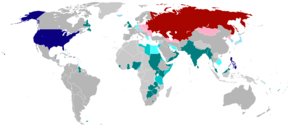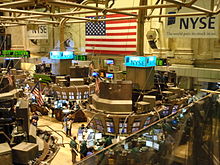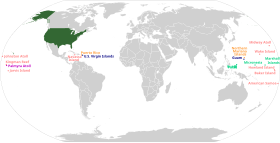Super Power

U.S. President Ronald Reagan andSoviet General Secretary Mikhail Gorbachev, then leaders of the Cold War's rival superpowers, meeting inGeneva, Switzerland in November 1985
Superpower is a term used to describe a statewith a dominant position, which is characterised by its extensive ability to exertinfluence or project power on a global scale. This is done through the combined-means of economic, military, technological and cultural strength, as well as diplomatic and soft powerinfluence. Traditionally, superpowers are preeminent among the great powers.
The term was first applied post World War II to the British Empire, the United States and the Soviet Union. However, after the end ofWorld War II and the Suez Crisis in 1956, the United Kingdom's status as a superpower was greatly diminished, leaving just the United States and Soviet Union as superpowers. For the duration of the Cold War the United States and the Soviet Union came to be generally regarded as the two remaining superpowers, dominating world affairs. At the end of the Cold War and the dissolution of the Soviet Union in 1991, only the United States appeared to fulfill the criteria of being a world superpower.[1][2][3]
Alice Lyman Miller defines a superpower as "a country that has the capacity to project dominating power and influence anywhere in the world, and sometimes, in more than one region of the globe at a time, and so may plausibly attain the status of globalhegemony."[4]
Terminology and origin

A world map in 1945. According to William T.R. Fox, the United States (blue), the Soviet Union(red) and the British Empire (teal) were superpowers.
No agreed definition of what is a 'superpower' exists, and may differ between sources.[2]However, a fundamental characteristic that is consistent with all definitions of a superpower is a nation or state that has mastered the seven dimensions of state power: geography, population, economy, resources, military,diplomacy and national identity.[5]
The term was first used to describe nations with greater than great power status as early as 1944, but only gained its specific meaning with regard to the United States, the United Kingdom and its empire and the Soviet Unionafter World War II. This was because the United Kingdom, the United States and the Soviet Union had proved themselves to be capable of casting great influence in global politics and military dominance. The term in its current political meaning was coined by Dutch-American geostrategist Nicholas Spykman in a series of lectures in 1943 about the potential shape of a new post-war world order. This formed the foundation for the book The Geography of the Peace, which referred primarily to the unmatched maritime global supremacy of the British Empire and United States as essential for peace and prosperity in the world.
A year later, in 1944, William T. R. Fox, an American foreign policy professor, elaborated on the concept in the book The Superpowers: The United States, Britain and the Soviet Union — Their Responsibility for Peace, which spoke of the global reach of a super-empowered nation.[6] Fox used the word Superpower to identify a new category of power able to occupy the highest status in a world in which, as the war then raging demonstrated, states could challenge and fight each other on a global scale. According to him, there were (at that moment) three states that were superpowers: the United Kingdom, the United States, and the Soviet Union. The British Empire was the most extensive empire in world history and considered the foremost great power, holding sway over 25% of the world's population[7] and controlling about 25% of the Earth's total land area, while the United States and the Soviet Union grew in power before and during World War II.
According to Lyman Miller, "The basic components of superpower stature may be measured along four axes of power: military, economic, political, and cultural (or what political scientist Joseph Nye has termed “soft power”).[4]
In the opinion of Kim Richard Nossal ofQueen's University in Canada, "generally this term was used to signify a political community that occupied a continental-sized landmass, had a sizable population (relative at least to other major powers); a superordinate economic capacity, including ample indigenous supplies of food and natural resources; enjoyed a high degree of non-dependence on international intercourse; and, most importantly, had a well-developed nuclear capacity (eventually normally defined as second strike capability)."[2]
In the opinion of Professor Paul Dukes, "a superpower must be able to conduct a global strategy including the possibility of destroying the world; to command vast economic potential and influence; and to present a universal ideology". Although, "many modifications may be made to this basic definition".[8] According to Professor June Teufel Dreyer, "A superpower must be able to project its power, soft and hard, globally."[9] In his book, Superpower: Three Choices for America's Role in the World, Dr. Ian Bremmer, president of the Eurasia Group, argues that a superpower is "a country that can exert enough military, political, and economic power to persuade nations in every region of the world to take important actions they would not otherwise take."[10]
Superpowers of the past

Major economies from 1 AD to 2003 AD according to Angus Maddison's estimates[11]
There have been many attempts by historians to apply the term superpower retrospectively, and sometimes very loosely, to a variety of entities in the past. Recognition by historians of these older states as superpowers may focus on various superlative traits exhibited by them. Examples of these ancient or historical superpowers include the British Empire,[6] Ancient Egypt,[12] the Hittite Empire,[13] the Median Empire, theAchaemenid Empire,[14] the Hellenistic Empire of Alexander the Great,[15] the Roman Empire,[16] the Maurya Empire,[17][18] theByzantine Empire, the Sassanian Empire, theRussian Empire, the Han Empire, the Tang Empire,[19] the Umayyad Caliphate,[20] theMongol Empire, the Ottoman Empire,[21] theSpanish Empire,[22] the First French Empire ofNapoleon,[23] and the Parthian Empire.
According to historical statistics and research from the OECD, until the early modern period,Western Europe, China, and India accounted for roughly ⅔ of the world's GDP.[24]
Cold War

This map shows two essentially global spheres during the Cold War in 1980.
NATO member states
Other allies of the U.S. and NATO
× Anti-communist guerrillas
Warsaw Pact member states
Socialist country allied with the Warsaw Pact
Other allies of the USSR
× Communist guerrillas
Socialist country not allied with the USSR and the Warsaw Pact
Neutral nations
× Other conflicts
The 1956 Suez Crisis suggested that Britain, financially weakened by two world wars, could not then pursue its foreign policy objectives on an equal footing with the new superpowers without sacrificing convertibility of its reserve currency as a central goal of policy.[25] As the majority of World War II had been fought far from its national boundaries, the United States had not suffered the industrial destruction nor massive civilian casualties that marked the wartime situation of the countries in Europe or Asia. The war had reinforced the position of the United States as the world's largest long-term creditor nation[26] and its principal supplier of goods; moreover it had built up a strong industrial and technological infrastructure that had greatly advanced its military strength into a primary position on the global stage.[27]Despite attempts to create multinational coalitions or legislative bodies (such as theUnited Nations), it became increasingly clear that the superpowers had very different visions about what the post-war world ought to look like, and after the withdrawal of British aid to Greece in 1947, the United States took the lead in containing Soviet expansion in theCold War.[28]
The two countries opposed each other ideologically, politically, militarily, and economically. The Soviet Union promoted the ideology of communism: planned economyand a one-party state, whilst the United States promoted the ideologies of liberal democracyand the free market. This was reflected in theWarsaw Pact and NATO military alliances, respectively, as most of Europe became aligned with either the United States or the Soviet Union. These alliances implied that these two nations were part of an emergingbipolar world, in contrast with a previously multipolar world.[citation needed]
The idea that the Cold War period revolved around only two blocs, or even only two nations, has been challenged by some scholars in the post–Cold War era, who have noted that the bipolar world only exists if one ignores all of the various movements and conflicts that occurred without influence from either of the two superpowers.[29] Additionally, much of the conflict between the superpowers was fought in "proxy wars", which more often than not involved issues more complex than the standard Cold War oppositions.[30]
After the Soviet Union disintegrated in the early 1990s, the term hyperpower began to be applied to the United States, as the sole remaining superpower of the Cold War era.[2]This term, popularized by French foreign minister Hubert Védrine in the late 1990s, is controversial and the validity of classifying the United States in this way is disputed. One notable opponent to this theory, Samuel P. Huntington, rejects this theory in favor of a multipolar balance of power. Other international relations theorists, such asHenry Kissinger, theorize that because the threat of the Soviet Union no longer exists to formerly American-dominated regions such as Western Europe and Japan, American influence is only declining since the end of the Cold War, because such regions no longer need protection or have necessarily similar foreign policies as the United States.[31]
The Soviet Union and the United States fulfilled the superpower criteria in the following ways:
Post–Cold War era

The New York Stock Exchange trading floor. Economic power such as a largenominal GDP and a world reserve currency are important factors in projection of hard power.
After the dissolution of the Soviet Union in 1991 which ended the Cold War, the post–Cold War world has in the past been considered by some to be a unipolarworld,[40][41] with the United States as the world's sole remaining superpower.[42] In 1999, Samuel P. Huntington wrote, "The United States, of course, is the sole state with preeminence in every domain of power – economic, military, diplomatic, ideological, technological, and cultural – with the reach and capabilities to promote its interests in virtually every part of the world." However, he rejected the claim that the world was unipolar: "There is now only one superpower. But that does not mean that the world is unipolar," describing it instead as "a strange hybrid, a uni-multipolar system with one superpower and several major powers." He further wrote that "Washington is blind to the fact that it no longer enjoys the dominance it had at the end of the Cold War. It must relearn the game of international politics as a major power, not a superpower, and make compromises."[43]
Experts argue that this older assessment ofglobal politics is too simplified, in part because of the difficulty in classifying theEuropean Union at its current stage of development. Others argue that the notion of a superpower is outdated, considering complex global economic interdependencies, and propose that the world ismultipolar.[44][45][46][47]
A 2012 report by the National Intelligence Council said that America's superpower status will have eroded to merely being first among equals by 2030, but that the US would remain highest among the world's most powerful countries because of its influence in many different fields and global connections that the great regional powers of the time would not match.[48] Additionally, some experts have suggested the possibility of the United States losing its superpower status completely in the future. Citing speculation of the United States relative decline in power to the rest of the world, economic hardships, a declining dollar, Cold War allies becoming less dependent on the United States and the emergence of future powers around the world.[49][50][51][52]
Some people doubt the existence of superpowers in the post–Cold War eraaltogether, stating that today's complex global marketplace and the rising interdependency between the world's nations has made the concept of a superpower an idea of the past and that the world is now multipolar. However, while the military dominance of the United States remains unquestioned for now and its international influence has made it an eminent world power, countries such as China, India, Brazil and Russia are inventing new ways to counter US military supremacy (namely space) and are making great strides in science, literature, soft power, and diplomacy.[44][45][46][47]
Potential superpowers
The term 'potential superpowers' has been applied by scholars and other qualified commentators to the possibility of several states achieving superpower status in the 21st century. Due to their large markets, growing military strength, economic potential, and influence in international affairs,China,[53][54][55] the European Union,[56][57]India,[58] and Russia[59] are among the political entities most cited as having the potential of achieving superpower status in the 21st century. Many historians, writers, and critics have expressed doubts, however, whether any of these countries would ever emerge as a new superpower.[60][61] Some political scientists and other commentators have even suggested that such countries might simply be emerging powers, as opposed to potential superpowers.[62]
Besides those mentioned above, a limited number of observers have also discussed, though ultimately dismissed, Brazil having the potential to emerge as a superpower.[63]
The record of such predictions has admittedly not been perfect. For example, in the 1980s, some commentators thought Japan would become a superpower, due to its large GDP and high economic growth at the time.[64]However, Japan's economy crashed in 1991, creating a long period of economic slump in the country which has become known as The Lost Years. As of August 2012, Japan had yet to fully recover from the 1991 crash.[65]

Comments
Post a Comment